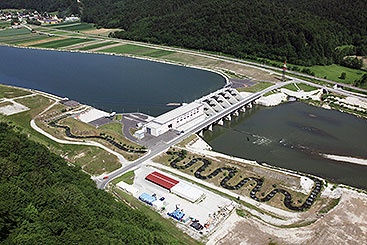A hydropower balancing act

A hydropower balancing act
The new Guiding Principles on Hydropower offer a holistic approach to hydropower development plans, increasing energy production while allowing environmental conditions to improve.

Hydropower plant Arto-Blanca at the Sava River, Slovenia. Hydropower generates renewable energy but also has a negative impact on the environment – the challenge is to strike the right balance.
© Hidroelektrarne Na Spodnji Savi
Transitioning energy systems towards renewables is one of today’s key challenges. Besides actions to increase the efficiency of energy use, societies need additional renewable energy sources to reduce greenhouse gas emissions in order to combat climate change. Next to wind, solar and biomass, hydropower has an important role in providing renewable energy and stabilising the electricity grid. However, as with other forms of renewable energy, hydropower cannot be considered as sustainable per se. Its negative impacts on, for example, fish populations, sediment transport and adjacent wetlands require a balanced approach for the preservation of healthy ecosystems.
Danube countries are getting closer to finding that balance. They have tasked the ICPDR to address the challenge of developing sustainable hydropower within the existing legal and policy framework. At the 2010 Danube Ministerial Meeting, ministers from all ICPDR countries asked the Commission to “organise in close cooperation with the hydropower sector and all relevant stakeholders a broad discussion process with the aim of developing guiding principles on integrating environmental aspects in the use of existing hydropower plants, including a possible increase of their efficiency, as well as in the planning and construction of new hydropower plants”.
This activity was launched in 2011, building on the achievements of a similar process for inland navigation. The aim of the hydropower process is to find an agreement on how to address existing hydropower and to establish guidelines for how and where to develop hydropower in the future.
Led by experts. As lead countries, Austria, Romania and Slovenia committed to a stronger role within the ICPDR in order to steer the development of the Guiding Principles on Hydropower. This work was supported by a team of experts with representatives from energy and environmental administrations, the European Commission, energy community, sector representatives as well as environmental interest groups and the scientific community.
After a workshop and a number of meetings, the team developed an assessment report and a collection of case studies and good practice examples to accompany the Guiding Principles. The interim results of the work of the team of experts were presented and discussed at an international conference in March 2013 in Ljubljana, with the participation of more than 90 representatives from 13 countries.
Providing guidance. After the conference, the Guiding Principles were finalised and adopted by the Danube countries in June 2013 and are now also available in print. The Guiding Principles highlight the need for a sustainable approach to hydropower, taking into account social, economic and environmental issues. Furthermore, the Guiding Principles emphasise a holistic approach in energy policies, where hydropower development plans have to be linked with measures to increase energy efficiency along with an increase in other forms of renewable energy.
The Guiding Principles also suggest promoting technical upgrades for existing facilities and linking them with ecological restoration measures, such as fish migration aids or ensuring ecological flow. Practical case studies show that this combination can result in a winwin situation, allowing energy production to increase and environmental conditions to improve at the same time.
For new hydropower development, the Guiding Principles recommend a strategic planning approach based on two levels: a regional and a project-specific assessment. A regional assessment classifies river stretches by their suitability for hydropower development. In principle, protected areas, stretches of high ecological status or reference stretches are considered as suitable for exclusion from hydropower development, whereas remaining river stretches should be further classified according to energy management, environment and landscape criteria. The results of the regional assessment feed into the assessment of specific project applications, helping administrations take decisions which are transparent and reasonable.
Linking actions for success. The Guiding Principles are in need to be practically applied at the national level and should be linked to renewable energy action plans and river basin management plans to accelerate the increase in the share of renewable energy while meeting environmental protection goals.
The results of the hydropower guidance activities will have significant implications not just for the Danube region, but because they are also expected to provide an important contribution to worldwide discussions on how security of water, energy and food are inextricably linked and that actions in one area have impacts in one or both of the others. A roundtable discussion on this topic took place in November 2013 in Sarajevo where the Guiding Principles were presented and follow-up actions discussed.
The hope is that this process will bring transparency and openness to decisions affecting water and energy made by ministries and hydropower companies in the years to come.
For more information or for a copy of the Guiding Principles, please contact the ICPDR Secretariat via www.icpdr.org.






